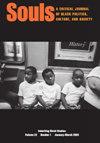“Shame Upon the Guilty City”: Riots and White Rage in the American Past and Present
IF 0.1
4区 哲学
Q4 ETHNIC STUDIES
引用次数: 0
Abstract
On May 14, 1838 abolitionists, black and white, converged in Philadelphia for the dedication of a newly erected building constructed as a meeting place to freely exchange ideas about liberty and equality for all. Three days later, on May 17th, the building was in ashes, burned to the ground by a white mob while government officials did little to intervene. Philadelphia, the former capital of the nation known throughout the country as a beacon of freedom and hub of abolitionism, became another setting of collective racial violence fueled by white rage. In response to the events, abolitionist Frederick Douglass condemned Philadelphia scathingly writing, “Shame Upon the Guilty City!” Almost two centuries later, the nation’s Capitol and symbol of liberty was besieged by a wrath-filled, mostly white mob in a manner similar to the Philadelphia riot of 1838. The preconditions of both violent attacks, the role of the state in their unfolding, and subsequent historical amnesia in their wake underscore the cyclical nature of white rage. This article argues that analyzing the example of Pennsylvania Hall’s destruction alongside the Capitol insurrection reveals historical trends within violent rioting incited by threats to the status quo of white hegemony.“罪恶之城的耻辱”:美国过去和现在的暴乱和白人愤怒
本文章由计算机程序翻译,如有差异,请以英文原文为准。
求助全文
约1分钟内获得全文
求助全文

 求助内容:
求助内容: 应助结果提醒方式:
应助结果提醒方式:


